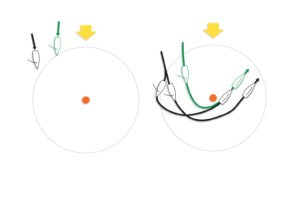Some of the trickiest rules are the ones that set the requirements for sailing the course. The problem in writing these rules is that they must work for the myriad course configurations that are used, for the many different methods that race committees use to signal the course, and for the variety of sailing instructions that describe courses and the procedures for signaling them.
Rule 28, Sailing the Course, is the main rule to study (see box), but the definitions Start, Finish, and Mark are also important, as well as Rules J2.1(4), J2.2(5), and J2.2(6). This month, Ill discuss Rule 28 and make some recommendations to prevent ambiguities in sailing instructions that can result in a request for redress and ruin an otherwise excellent race.
A course is specified once you know the following items: Descriptions of all marks, the starting line, and the finishing line; the marks that are “rounding marks,” the order in which the rounding marks must be passed, and the side on which each mark must be left.
Rules 28 and J2.1(5) refer to four types of marks: starting line marks, finishing line marks, rounding marks and boundary marks–i.e., marks that “bound” a leg of the course. The rules do not define the terms “rounding mark” and “boundary mark.” But you can infer their definitions from careful study of Rule 28. Rule 28.1s first sentence, commonly called “the string rule,” says that an imaginary string that unreels in your wake as you sail the course must, when pulled taut, touch each rounding mark. From this we can infer that a rounding mark is a mark you must sail to and round on the required side; a boundary mark is a mark that you must leave on a specified side but that your string need not touch.
Consider the example shown in the diagram (taken from an old U.S. Appeal). The sailing instructions required the boats to start, then leave Mark A to port, Mark B to starboard, Mark C to port, and finish. After rounding A to port, Tom sailed directly to C, while Jerry sailed to B and looped round it to starboard with a 240-degree clockwise turn before sailing to C.
Did either boat break Rule 28? The answer depends on what else the sailing instructions said about Marks A, B, and C. Sailing instructions are now required by Rule J2.1(5) to “identify all rounding marks.” If A, B, and C were all identified as rounding marks, then Tom broke Rule 28.1 because his string passes directly from A to C and does not touch B. Jerry complied with the rule because his string touches all three rounding marks and leaves each one on the required side.
However, if only A and C, but not B, were listed in the sailing instructions as rounding marks, then Tom met the string test because his string touches both rounding marks. Whether or not Jerry broke a rule in this case depends on what the sailing instructions said about Mark B. If B wasnt a rounding mark and wasnt a starting or finishing mark, it had to be a boundary mark. If the sailing instructions merely said that B was to be left to starboard while sailing from A to C, then Jerrys course was permissible because while sailing from A to C, and looping B, Jerry left B on his starboard side. On the other hand, if a sailing instruction stated that boats were not permitted to pass north of B on the leg from A to C, then Jerry broke that sailing instruction while he was looping B.
I hope all of you who write sailing instructions are paying attention! To avoid ambiguities, you must identify as rounding marks those marks that you want boats to sail to and actually round. Also, if you want a mark to be a boundary mark, then state carefully just what it is you want the boats to do as they pass it. Returning to the example, if you really want the boats to stay south of Mark B, then describe the restriction completely and consider adding a statement that the line north from B is an obstruction. If you do that, then boats will be able to invoke Rules 18 and 19 when near that line to avoid being forced by another boat to cross it (see the Definition Obstruction).
Finally, here are three frequently asked questions about rounding marks.
How does the string rule work when a gate is used instead of single leeward mark? The recommended sailing instruction when a gate is used is: “Boats shall sail between the gate marks from the direction of the previous mark and round either gate mark.” (See Appendix K.) In this case, each boat’s string must either leave the port gate mark to port and touch it or leave the starboard gate mark to starboard and touch it. Both gate marks should be identified as rounding marks and a sailing instruction should state that boats are required to round only one of them.
What if a boats string makes an extra 360-degree turn around a mark? Provided she leaves the mark on the required side initially and while making her extra turn, the boat does not break the string rule (see ISAF Case 90).
How can you correct your error if you round a mark to port that you were required to round to starboard?Return to the mark and round it to starboard to “unwind” your string. Then, wind your string around the mark on the required side by rounding the mark to starboard a again.
Other rules business
The International Sailing Federation has deleted Rule A8.2 and has decided to do so on June 1, rather than waiting until the next revision of the Racing Rules of Sailing is published in 2005. Rule A8.2, the second of three tie-breaking provisions in the Scoring appendix, broke series ties in favor of the boat that scored better than the other tied boat (or boats) the most. With Rule A8.2 deleted, series ties will now be broken using only Rules A8.1 and A8.3. That means that ties will be broken in favor of the boat with the most first places, then second places, etc., as provided by Rule A8.1. If a tie is unbroken by that rule, then it will be broken in favor of the boat that had the best score in the last race of the series.
This is the first change that ISAF has made in the 2001 racing rules (except for Section II of the Appendices, which ISAF may change at any time). Last year ISAF adopted a policy of not changing a racing rule until 2005 unless the need for the change was particularly compelling. The scoring systems in Appendix A were designed to prevent a boat from improving her series position by withdrawing from a race after coming ashore–a tactic called “strategic withdrawal.” Rule A8.2 was new in 2001. Shortly after it was published, it was discovered that, under certain possible arrangements of scores, a boat involved in a three-way tie could improve her series position by strategic withdrawal. It was for this reason that ISAF decided to delete the rule. In my opinion, there was another good reason to delete the rule–it was not at all clear how to apply it when three or more boats were tied and throwouts were permitted.
E-mail for Dick Rose may be sent to rules@sailingworld.com.









